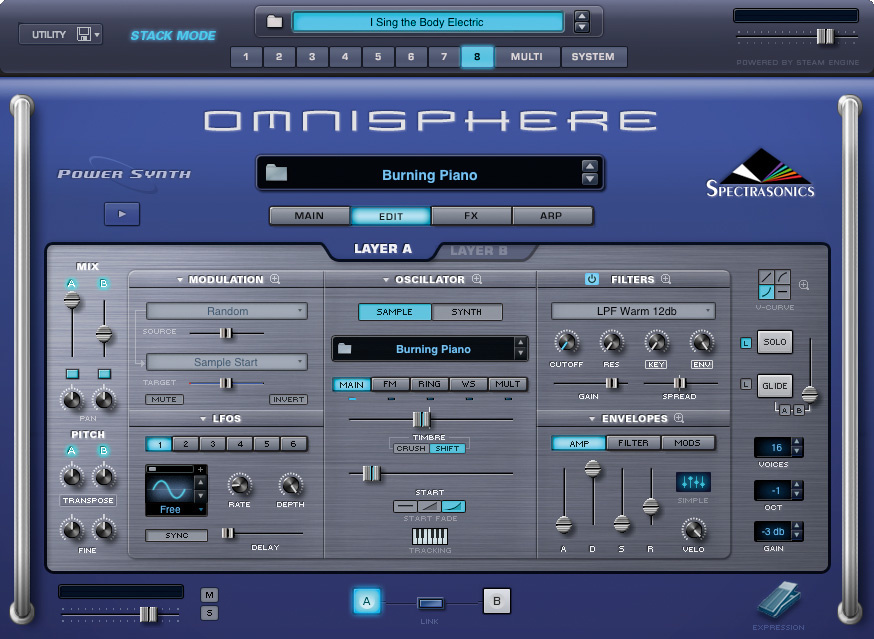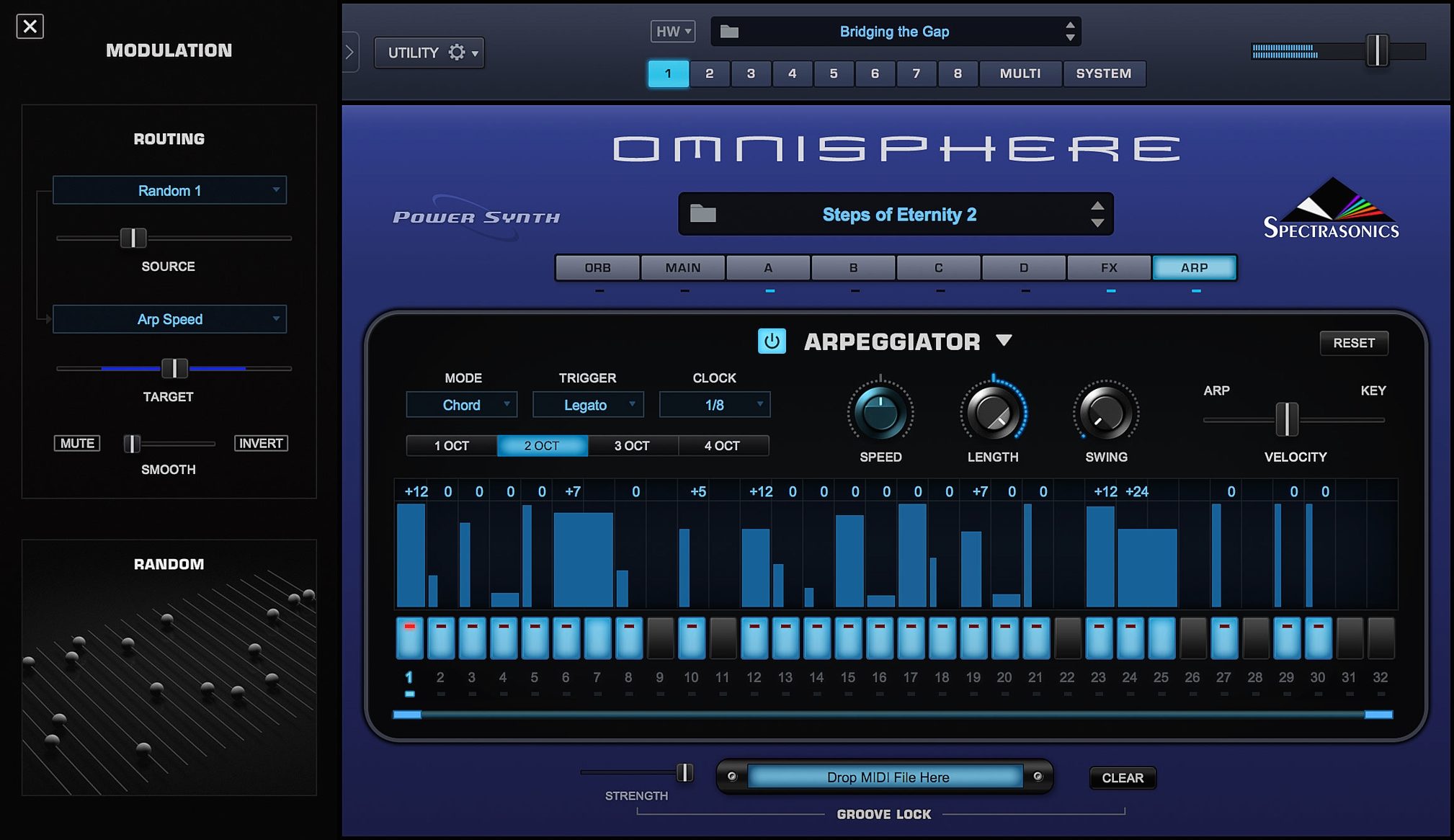Spectrasonics released their flagship synthesizer Omnisphere back in 2008. Since then it’s become known to professional sound designers and discerning producers as a feature-rich synth that’s capable of creating lush organic and synthetic soundscapes in the studio in addition to being an expressive and fully customizable performance tool.
Spectrasonics Omnisphere 2.6 - Cutting-edge virtual instrument and synthesizer. Spectrasonics Omnisphere 2.6 is a completely re-injected version of its extremely popular predecessor 'Omnisphere' but with an unbelievable number of new features and improvements.Spectrasonics have worked meticulously on every feature within Omnisphere 2 whether it's the 400 new DSP waveforms, 3,000 new patches. Live Mode was designed for use in a live performance environment, but is also an inspiring way to interact with the sounds of Omnisphere 2 in studio situations. It’s especially useful for recording multi-Part performances using a single MIDI track in your host sequencer.

The highly anticipated Omnisphere 2 was recently released and boasts many features that expand its sonic palette even further. It now includes a library of more than 12,000 classic and modern sounds that includes the Spotlight EDM library, all of which is easily accessible through Omnisphere 2’s intuitive new browser. Spectrasonics Omnisphere 2 is one of the most popular plugins among Splice users – Sign up for a free Splice account to download full Abelton Live, FL Studio, and Logic projects that make use of Omnisphere 2’s features and read on to discover some of the ways that it can contribute to your production toolkit.

Main Page
Omnisphere 2’s Main Page is where you’ll access most of its primary controls. It’s here that you can adjust global tuning and performance parameters that affect all aspects of Omnisphere 2’s sound and behavioral characteristics. The Main Page is also where you can adjust global parameters such as overall amplitude gain, MIDI channel routing, and audio output routing. The Master Filter section at the bottom of the Main Page provides you with a global Highpass and global Lowpass filter with adjustable Cutoff and Resonance controls.
Omnisphere 2.6 Plugin underpins a recently upgraded, high goals interface with help for HiDPI shows. The modernized GUI is presently simpler to utilize and resizable to fit serenely into your workspace. Since AAX module is only a wrapper. Omnisphere 2.5 Serial Key System Requirements: Following are the base necessities for utilizing this program.
Notes view offers an overview of the currently selected patch, while Layers view provides a more detailed look at the various layers that combine to create it. Each patch that you create using Omnisphere 2 can be constructed of components derived from both Waveforms and Soundsources, which you can freely explore by cycling through them in this window.
Soundsource Zoom gives you further control over the sound and behavior of Soundsources by allowing you to adjust virtual microphone placement, selection of playback algorithms, articulation modes, legato settings, and more.
The Oscillator Zoom section provides you with advanced options for sculpting your sounds and is the center of Omnisphere 2’s sound design capabilities. It’s here that you can choose from over 400 available wavetables and access several synthesis modes including FM, RM, Waveshaper, Unison, Harmonia, and Granular. You can use the Shape, Symmetry, and Hard Sync sliders to adjust the shape of the selected wavetable and alter its characteristics.
Orb
Omnisphere 2’s Orb is one of its most unique and defining features, and functions equally well as both a production and performance tool. The Orb allows you to instantly manipulate a sound in many different ways by introducing dynamic gestures to macro parameter automations in a way that’s far superior to what’s possible with a standard X/Y controller. Spectrasonics has also developed the Omni TR controller app for Apple iPad which is the perfect controller for the Orb and is available for free at Apple’s digital App Store. Every single patch in Omnisphere 2 has this capability, and operation of the Orb couldn’t be simpler. The closer to the edges of the circle the cursor is moved, the more dramatic the changes will be – moving the cursor to the center of the Orb or pressing the Clear button returns the sound to its original state. The overall intensity of the sound modification is determined with the Depth slider. A completely new set of manipulations can be chosen at any time by simply clicking the Dice button, which instantly creates a brand new group of modifications and effects. The Orb can also be setup manually and used as a modulation source in Omnisphere 2’s Mod Matrix or automated within your DAW.
Audio Import
New to Omnisphere’s latest edition is the ability to import your own audio for use as Soundsources. This feature allows you to process your own audio the same way you would with any of the included Factory Soundsources. You can manipulate your audio using any of Omnisphere 2’s synthesis capabilities as well as any of the onboard effects modules provided. This means that you can import any audio loop, vocal sample, or even an entire mix to transform the audio into something completely different. See what Spectrasonics founder Eric Persing has to say about some of Omnisphere 2’s latest features in the video below:
FX
Omnisphere 2 comes with a powerful selection of 58 high quality effects that can be used as either sends or inserts. Almost all of the FX parameters loaded in Part Racks can be modulated with any modulation trigger source, meaning that FX can be fully integrated into the synthesis architecture and character of a patch, which makes using them much more integrated and powerful than using standard FX plugins alone. In addition to individual FX Presets you can also load or save Rack Presets, which recall entire FX chains with all of their settings intact.
Arpeggiator
Omnisphere 2 has a built-in Arpeggiator that features multiple modes and trigger options paired with a variable-length 32-step Pattern Programmer. Version two provides enhanced melodic flexibility with the addition of a per-step note transposition feature.
Mixer
The Mixer section offers a comprehensive overview of all Parts contained within a Multi. It provides you with Mute and Solo switches for fine-tuning specific Parts and level sliders for mixing the various Parts together to taste. A Pan control is also included for placing each Part within the stereo field, as well as four Aux Sends which correspond to the FX section.

Stack Mode
Omnisphere 2’s Stack Mode gives you fine control over specific performance and playability parameters. Stack Mode makes it possible to create splits, layers, and crossfades for up to eight Parts simultaneously, all controlled from a single MIDI track or from a single controller. With Notes, each Part region is mapped to a MIDI note range, allowing you to map splits, layers, and crossfades across your keyboard. With Velocity, each Part region responds to a specific velocity range, which causes different Part regions to be triggered by playing harder or softer. With CC, Part regions can be switched and crossfaded using MIDI control change messages.
Live Mode
Live Mode allows you to seamlessly switch and layer patches on the fly. Live Mode was designed for use in a live performance environment, but is also an inspiring way to interact with the sounds of Omnisphere 2 in studio situations. It’s especially useful for recording multi-Part performances using a single MIDI track in your host sequencer. The Live Mode page has eight slots which each correspond to an Omnisphere 2 Part.The Omni TR controller app mentioned above also works with Live Mode and allows you to quickly stack and activate Parts. Patch names are always displayed in large and easy to read type so that they are clearly visible while performing on stage.
Browser
Omnisphere 2 ships with a massive library of over 12,000 sounds – its Browser offers a useful way to search, filter, and browse its contents. There are two types of Browsers in Omnisphere 2: the Full Browser and the Mini-Browser. The Full Browser occupies the entire Omnisphere 2 user interface, which allows for more refined searches and displays more results. The Mini-Browser occupies only the left area of the interface which allows the controls to remain accessible throughout and is convenient for editing sounds while browsing.
With Omnisphere 2, Spectrasonics have stayed true to the quality and character of the original Omnisphere while adding a host of brand new features that are sure to please both newcomers and long-time users alike. It’s currently available in AU, VST, RTAS, and AAX formats for both 32-bit and 64-bit systems. You can explore more of Omnisphere 2’s features and sounds by Splicing the projects below!
Recording Live Mode Omnisphere 2 4
Splice is the cloud platform for music creation, collaboration and sharing.
July 7, 2015
Omnisphere 2 Pc
If the user doesn’t like what the Orb has created, a complete new set of manipulations can be chosen by simply rolling the “Dice” button, which instantly creates a brand new group of intelligent sonic modifications and effects to try. There’s no limit to how many serendipitous sonic variations the Orb can create – opening up the vast power of the STEAM engine to every user, regardless of synthesis knowledge.
The tactile experience of moving the cursor around the Orb space on the iPad with a finger to create variations in the sound is remarkably musical. Where standard controllers might change one or two simple parameters in a linear manner, the Orb morphs a host of parameters that are patch specific, and easily changed on-the-fly.
The Inertia slider of the Orb allows the user to create a ‘movement trail’ after letting go of the Orb, just like a ball might roll and bounce off the walls of a circular enclosure, adding a musical symmetry to the “performance” of an Orb interaction.
Users can also record their performance movements directly into the Orb and play the performance back in sync with their controller or host. The Orb’s movements and sonic results are saved within the patch, multi or the host’s session for later recall. The movement of the Orb can also be automated in the user’s host.